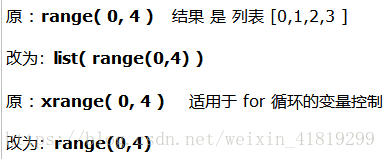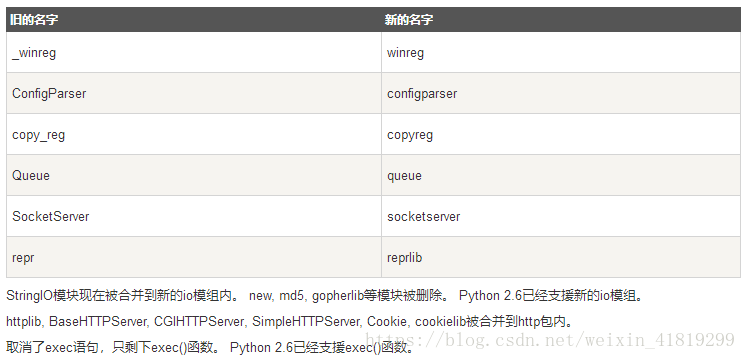python2与python3的区别
发布时间:2019-09-06 08:51:59编辑:auto阅读(2122)
-
新增nonlocal在闭包中改变临时变量
-
print加()
-
Unicode编码存储字符串
-
数据类型新增bytes
-
除法/不需要转float
-
异常捕获 加as
-
range
-
八进制表示 只能0o1000
-
不等运算符 只能!=
-
去掉了repr表达式``
-
模块改名
-
字典的关键字 用属性代替函数
-
从键盘键入字符串input
-
map、filter、reduce
-
打开文件 open
-
chr( K ) 与 ord( c )的范围
-
字节数组对象bytearry
说明:标注?????是暂时没遇到且看不懂的,做个标记。常见的区别有print,range,open,模块改名,input,整除/,异常 except A as B
为了不带入过多的累赘,Python 3.0在设计的时候没有考虑向下相容。过渡版本Python2.6基本使用了Python 2.x的语法和库,同时考虑了向Python 3.0的迁移,允许使用部分Python 3.0的语法与函数。
目录
python2没有nonlocal关键字,要修改临时变量只能将其改成可变数据类型,如数组。b=[a]
print()函数代替print语句
Python 3加入 Unicode 字符串,用以编码存储字符串。比如用 utf-8可以用来输入中文
Python 3去掉long类型,新增了bytes。可以看成是“字节数组”对象,每个元素是 8-bit 的字节,取值范围 0~255。
在 python 3中字符串以 unicode 编码存储,当写入二进制文件时,字符串无法直接写入writr(或读取),必须以某种方式的编码(encode编码/decode解码)为字节序列后,方可写入。换句话说str类型的字符串无法write进文件,要将str字符串encode为bytes才能write
a='asdfg'
print(type(a))
b=a.encode()
print(type(b))
c=b'qwe'
print(type(c))
d=c.decode()
print(type(d))
运行结果:
<class 'str'>
<class 'bytes'>
<class 'bytes'>
<class 'str'>
注意:type类型的数据不能当成普通的int型去修改
s="ABCD"
b=s.encode("gbk")
print (b[0]) # 输出65
b[0] = 66 #TypeError: 'bytes' object does not support item assignment
Python 3整数之间做除法可以得到浮点数的结果,不需要进行数据格式转换1/2=0.5
Python 2整数int间除法结果为把运算结果去尾的整数1/2=0,3/2.0=1.5
Python 3 中 except exc as var
Python 2中 except exc , var
?????????????

Python 3 中 range()
Python 2 中 xrange()
?????????????


Python 2 中 0o1000 或者01000
Python 3 中 只能0o1000
Python 2 中 != 或者<>
Python 3 中 只能!=
?????????????

????????????????

线程模块:Python 2 中 thread,Python 3 中_thread
Python 3去掉iterkeys()、 dict.has_key(),用.keys()、.items 和.values()方法返回迭代器
dict1={'a':1,"b":2,"c":3}
print(dict1.keys())
print(dict1.values())
print(dict1.items())
运行结果:
dict_keys(['a', 'b', 'c'])
dict_values([1, 2, 3])
dict_items([('a', 1), ('b', 2), ('c', 3)])
Python 2 中 raw_input("提示信息")用以输入字符串 ; input()用以输入数字
Python 3 中input("提示信息")将所有输入默认为字符串
Python 2 中 map、filter是内置函数,输出为列表
Python 3 中 map、filter是类,返回可迭代的对象,可用next()进行迭代
“对于比较高端的 reduce 函数,它在 Python 3.x 中已经不属于 built-in 了,被挪到 functools 模块当中。”
Python 2 中 file(。。。)或oen(。。。)
Python 3 中 只能open(。。。)
???????????????
python 2.4.2以前
chr( K ) 将编码K 转为字符,K的范围是 0 ~ 255
ord( c ) 取单个字符的编码, 返回值的范围: 0 ~ 255
python 3.0
chr( K ) 将编码K 转为字符,K的范围是 0 ~ 65535
ord( c ) 取单个字符的编码, 返回值的范围: 0 ~ 65535
python3新增,将多个bytes字节类型数据组成数组。
(1) 初始化
a = bytearray( 10 )
# a 是一个由十个字节组成的数组,其每个元素是一个字节,类型借用 int
# 此时,每个元素初始值为 0
(2) 字节数组 是可变的
a = bytearray( 10 )
a[0] = 25
# 可以用赋值语句更改其元素,但所赋的值必须在 0 ~ 255 之间
(3) 字节数组的切片仍是字节数组
(4) 字符串转化为字节数组
#coding=gbk
s ="你好"
b = s.encode( "gbk") # 先将字符串按某种“GBK”编码方式转化为 bytes
c = bytearray( b ) #再将 bytes 转化为 字节数组
也可以写作
c = bytearray( "你好", "gbk")
(5) 字节数组转化为字符串
c = bytearray( 4 )
c[0] = 65 ; c[1]=66; c[2]= 67; c[3]= 68
s = c.decode( "gbk" )
print ( s )
# 应显示: ABCD
(6) 字节数组可用于写入文本文件
#coding=gbk
f = open("c:\\1234.txt", "wb")
s = "张三李四abcd1234"
# -------------------------------
# 在 python2.4 中我们可以这样写:
# f.write( s )
# 但在 python 3.0中会引发异常
# -------------------------------
b = s.encode("gbk")
f.write( b )
c=bytearray( "王五","gbk")
f.write( c )
f.close()
input("?")
参考网址:
http://www.runoob.com/python/python-2x-3x.html
https://www.cnblogs.com/hanggegege/p/5840005.html
上一篇: python3:常用模块
下一篇: python向mySQL批量插入数据的方
- openvpn linux客户端使用
51344
- H3C基本命令大全
50801
- openvpn windows客户端使用
41394
- H3C IRF原理及 配置
38194
- Python exit()函数
32685
- openvpn mac客户端使用
29578
- python全系列官方中文文档
28413
- python 获取网卡实时流量
23294
- 1.常用turtle功能函数
23256
- python 获取Linux和Windows硬件信息
21584
- Python搭建一个RAG系统(分片/检索/召回/重排序/生成)
1663°
- Browser-use:智能浏览器自动化(Web-Agent)
2394°
- 使用 LangChain 实现本地 Agent
1996°
- 使用 LangChain 构建本地 RAG 应用
1936°
- 使用LLaMA-Factory微调大模型的function calling能力
2268°
- 复现一个简单Agent系统
1968°
- LLaMA Factory-Lora微调实现声控语音多轮问答对话-1
2672°
- LLaMA Factory微调后的模型合并导出和部署-4
4470°
- LLaMA Factory微调模型的各种参数怎么设置-3
4302°
- LLaMA Factory构建高质量数据集-2
3067°
- 姓名:Run
- 职业:谜
- 邮箱:383697894@qq.com
- 定位:上海 · 松江
